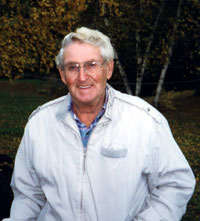In a world beset with environmental and economic horrors, a golf course is a disturbing sight. Okay, it’s not as disturbing as an oil slick on Prince William Sound, or the Cuyahoga River bursting into flames, or the coral reefs off Sri Lanka bleaching and dying.

Evil green monster (a traditional golf course).
But the proliferation of golf courses is symptomatic of the suburbanization of once-rural places, which is disturbing in its own creepy way. Golf courses replace habitat or farmland with sterile, carpet-smooth fairways. They cloister off yet more land for the wealthy. Instead of supporting plants or animals, they support rich guys tooling around in little carts, each chasing a tiny white ball the size of a dinosaur’s brain, which the game’s most vitriolic critics would point out is not entirely a coincidence.
But I have been to a golf course, and it was good. It was in North Ferrisburgh, Vt. It belongs to Dick Raymond, a 68-year-old with a frightening amount of energy and a gardening resume that would stun an ox. He has sold more than 2 million books on vegetable gardening, and has lectured all over the world. Although he’s not strictly organic, he subscribes to such simple beliefs as combating lawn weeds by planting more grass seed and mowing the lawn. He refined the “wide row method,” in which lots of vegetable seeds planted in wide rows yield the dual benefits of shading out weeds and reducing evaporation.

Raymond smiles for the camera.
Photo: Lisa Jones.
“I’m not a purist in general,” he says one morning in the house he shares with his wife of 50 years, Jan. “But I’m a purist on that golf course. All I ever use is Ivory liquid and occasionally vinegar on the weeds. It’s low maintenance, totally environmentally sound. People come to golf here who are allergic to chemicals. They love it because they know it’s safe.”
The golf course spreads out in front of the house. It looks green and soggy. It’s been a wet fall, and the course is in a flood plain. This bothers Dick not one bit. “One-sixtieth to one-thirty-second inch of silt per year comes down on the topsoil. It’s all topsoil. I don’t even need to use fertilizer,” he says. “The fertilizer comes in from upstream. Some places in there that’s four feet of topsoil. It’s the ultimate recycling.”
The golf course has nine holes. Four of the holes are par four and the rest are par three, which makes a par 31 course.
“Only 15 percent of golfers in the world break 100 on 18 holes,” says Dick. “What about the other 85 percent? Do they give a rat’s bum about bumps on a green? They want to have fun! Golf is a social game. We need more affordable, family-style recreation. If we can’t provide some outdoor, healthy, family recreation to our community, what are we doing? Money isn’t everything. It costs $8 for nine holes. It’s not a money-making thing. I’ve had as many as 13 people in a group with only four people playing. One was in a stroller. Now he’s four and he comes here and hits the ball himself!”
Raymond knows about that kind of vigor. “I’m nearly 70, and I still go two steps apiece up the stairs,” he says. “I’ve had a lot of fun. It’s been an uphill battle, but it’s been a fun one.”

